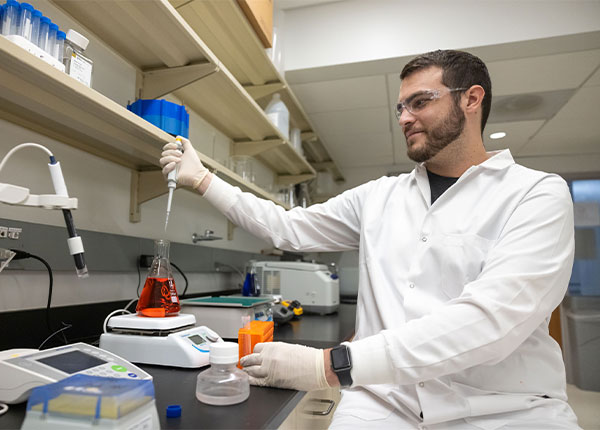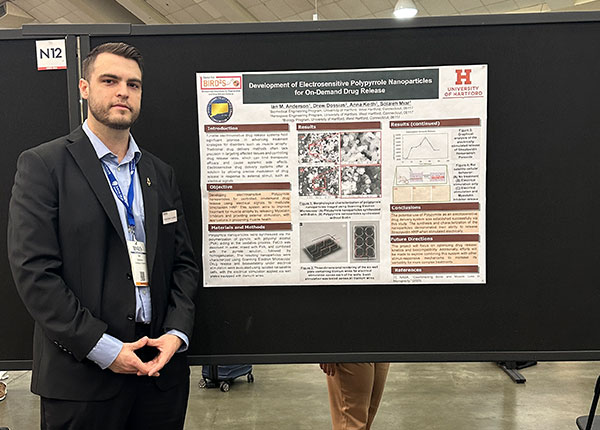

Ian Anderson ‘25 plans to continue his education at Worcester Polytechnic Institute to pursue a Doctor of Philosophy degree in biomedical engineering after graduation. The biomedical engineering student in CETA states that UHart has provided many opportunities to network and build connections through clubs, conferences, and internships, saying, “I met many interesting people in various environments and made connections that helped advance my career.” Ian explains that the resume and CV he developed at UHart gave him the competitive edge needed to secure a position in a PhD program.
Ian believes that UHart prepared him to achieve his professional goals because the biomedical engineering program offered nearly three years of hands-on research experience during his undergraduate career. He also presented his research at numerous events, including the Biomedical Engineering Society Annual Meeting and the NASA Connecticut Space Grant Consortium. “Those conferences gave me the exposure and experience I needed to enter the next stages of my academic journey.”
While a student, Ian interned at Oxford Performance Materials in South Windsor, where he worked on 3D-printed medical implants. He also interned at the Westport Astronomical Society the following summer, observing asteroid occultations via telescope and using various Python applications to analyze data. Both internships were part of the NASA Connecticut Space Grant.
Research was another significant component of Ian’s experience at UHart. He worked in the tissue engineering laboratory with Solaleh Miar, assistant professor of biomedical engineering. “I worked on various projects, including developing a novel phonomimetic bioreactor, creating electrosensitive polypyrrole nanoparticles for on-demand drug release, and developing a laryngotracheal organ-on-chip system.” He notes that Miar exposed him to many new ideas and opportunities, saying, “She constantly pushed me to try my hardest and strive for greatness. I am very grateful for all the faculty in CETA and the University of Hartford as a whole.”
In addition to Miar, Ian says that Takafumi Asaki, assistant dean and biomedical engineering program director, was much more than just his academic advisor and professor, stating, “He took the time to truly invest in ensuring my future was on the right track. I could not have accomplished what I did at UHart without Dr. Asaki.” Ian also served as president of the Biomedical Engineering Society, which Asaki advises, and as president of Tau Beta Pi, the engineering honor society. “During my time in Tau Beta Pi, I led the initiative to update the members' plaque in United Technologies Hall for the first time in over 15 years.”
Ian's favorite aspect of UHart is the close-knit community among students and faculty. “Being able to know everyone and interact directly with professors is very helpful for academic success. Having people to study with and bounce ideas off of is crucial. UHart is great because the people make it great.”
Ian Anderson '25, College of Engineering, Technology, and ArchitectureMy advice for incoming students? Appreciate the little things.